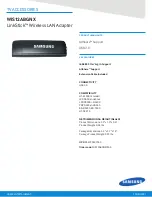
10.2.2 Receive FIFO
The receive FIFO can service the receiver of either channel A or channel B of the SCC.
If RXSRC (bit 1) of the Configuration Register (see page 41) is logic 1, the receive FIFO will
service SCC channel B. If RXSRC is logic 0, the receive FIFO will service SCC channel A.
If the FIFOs are enabled, an I/O read from either SCC Data Port (channel A or channel B)
will read a byte from the receive FIFO. If the FIFOs are not enabled, an I/O read from the SCC
Data Port will instead read directly from the internal receive buffer of the specified channel of the
SCC.
10.3 SCC configuration for FIFO operation
The interface between the SCC and the external FIFOs uses the SCC's DMA request
functions. The SCC must therefore be configured for DMA operation in order to use the external
FIFOs. In order to properly configure the SCC, certain bits in various SCC registers need to be
set in a specific manner, as shown on the following pages.
Because the data transfer between the FIFOs and the SCC is controlled entirely by
hardware, per-character transmit and receive interrupts should be disabled. Interrupts on transmit
underruns and/or special receive conditions should usually be enabled so that end-of-frame
conditions can be detected.
IMPORTANT
The DMA operation described in this section is
between the SCC and the external FIFOs, and is
handled entirely by the MPAP-100 hardware.
DMA is not supported between the MPAP-100 and
the host computer due to the lack of DMA facilities
on the PCMCIA bus.
The MPAP-100 is a single-channel device. Accordingly, most applications will use SCC
channel A for both transmit and receive operations. It is possible, however, to use a limited
portion of SCC channel B for receive operations (see page 29). The channel used for receive will
determine how the SCC must be configured.
Do not enable the FIFOs until the SCC has been properly configured for DMA
operation!
















































